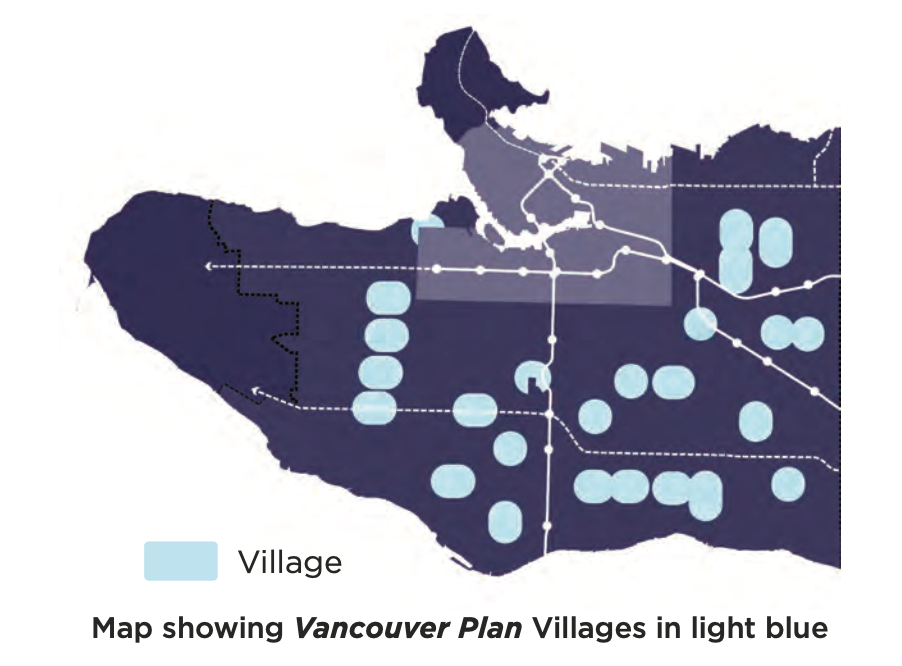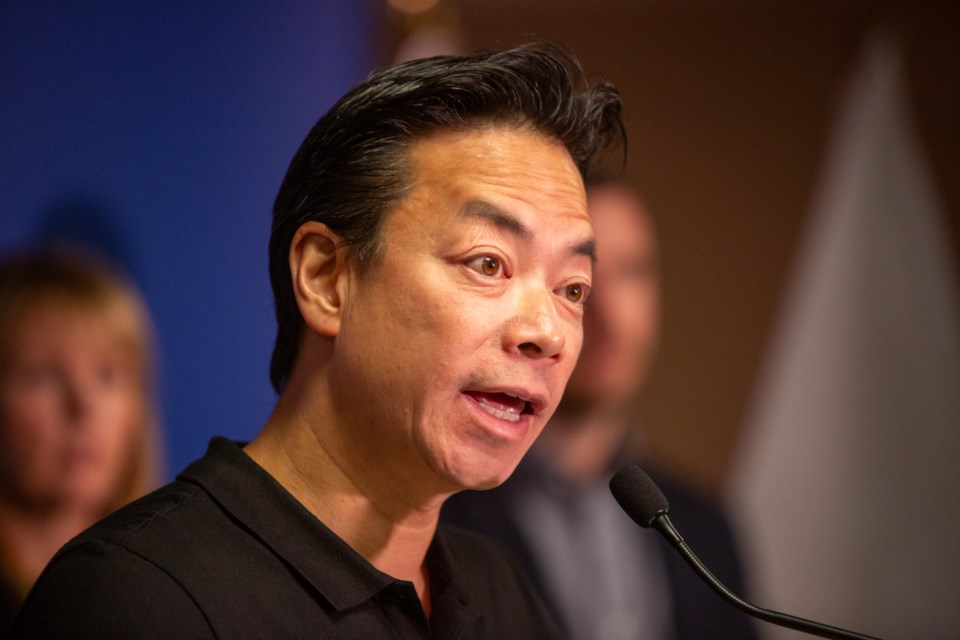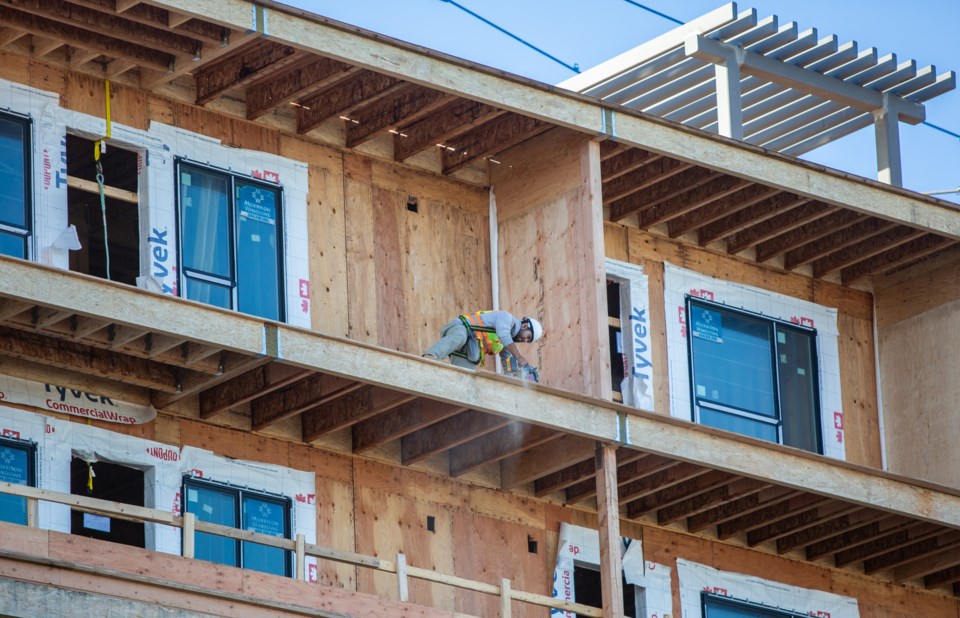The ABC Vancouver-dominated council is pushing to have 26 areas of the city prezoned to allow and accelerate the construction of all forms of housing.
City staff is currently in discussions with the provincial government to make amendments to the Vancouver Charter that would erase the need for a rezoning to occur in areas defined under the Vancouver Plan as “villages.”
The villages are concentrated outside the downtown core and spread from the Dunbar corridor to pockets in the northeast and southeast of the city, where the plan considers multiplexes, townhouses and low-rise apartments up to six storeys.
News of ABC Vancouver’s push for prezoning the villages came Wednesday via Mayor Ken Sim’s chief of staff, Trevor Ford, who spoke to reporters after a news conference at city hall.
Sim led the news conference in which he outlined a series of “bold policy ideas” he wants to implement to get more housing built in Vancouver. Accelerating construction in the 26 villages was mentioned, but prezoning was not.
“Being able to prezone is the real mover around these 26 villages,” Ford said.
“Part of this relies on the provincial government, and they have been amazing partners. We do know that they're looking at something next year in terms of charter changes. The other part of this is [getting] staff to immediately start the work on this, including prepping the ground for the prezoning.”

Six-storey apartments
Villages, as defined under the Vancouver Plan, “are envisioned to be oriented around a small collection of commercial and community uses that provide local jobs, daily needs and community place-making and social connections.”
New housing options in the form of multiplexes, townhouses and low-rise apartments up to six storeys will bring more people of different ages, incomes and backgrounds into the villages, the plan stated before it was passed by the previous council in July 2022.
In addition to speeding up construction in the villages, Sim outlined six other ideas that he plans to introduce in a motion at next week’s council meeting.
Those ideas are:
• Explore opportunities to increase housing density by rezoning land around the “underdeveloped” SkyTrain stations, including those at Nanaimo, 29th Avenue, Renfrew and Rupert.
• Review the city’s “shadow impact criteria and guidelines” for how new construction creates shadows on neighbouring buildings and spaces.
• Increase the maximum allowable floor plate size for residential towers to unlock additional housing units.
• Consider expanding and improving the city’s “certified professional program” to reduce the time, cost and delays associated with permitting times.
• Look to harmonize and otherwise align the Vancouver building bylaw with the BC Building Code, which governs how new construction, building alterations, repairs and demolitions are completed, with the goal of building more housing faster.
• Work with the provincial and federal governments to push for more enforcement on illegal short-term rentals.

'As quick as possible'
What Sim didn’t include in his list of ideas was how many housing units he envisioned being built and over what timeframe. He also wasn’t clear how many of the units would be targeted to renters, which comprise 75 per cent of newcomers to Vancouver.
“The timeframe is as quick as possible,” the mayor said. “We're not going to give a number on units. The role of the City of Vancouver is to create an environment where we can build more housing of all types as quickly as possible.”
Sim’s news conference, which was attended by all seven ABC Vancouver councillors, comes a few weeks after the provincial government announced housing targets for Vancouver and nine other municipalities.
Vancouver’ target, as set under the Housing Supply Act, was for the construction of 28,900 units over five years, which the city responded to in a Sept. 26 statement saying it plans to meet that goal.
It’s not clear how many of the units will be rental, or ensure a household pays no more than 30 per cent of their income on housing.
Sim used the word “bold” several times during the news conference to describe his ABC Vancouver team’s push on the housing file. How that push factored into Theresa O’Donnell leaving last month as the city’s head planner was not something Sim would elaborate on; the city's news release Sept. 18 said her job had "concluded."
“We don't comment on human resource issues,” the mayor said. “But what I can tell you is [I’m] really thankful for Theresa and everything she's done for our city. Today we're driving forward as to what we need to do to build more housing faster.”
'You prioritize nothing'
Green Party Coun. Adriane Carr told reporters after the news conference that she was worried ABC Vancouver’s focus on accelerating housing does not include homes for people most in need and on low incomes.
“Remember, this is the council that when staff delivered the update on our housing strategy, decided to amend it to take out affordable housing as the priority and just said to Theresa O’Donnell at that time to make permitting fast for everything,” Carr said.
“And you may remember I said, if you prioritize everything, you prioritize nothing.”
She also questioned ABC Vancouver’s push to develop areas around certain SkyTrain stations, where staff have repeatedly told council about the huge costs of infrastructure required for those areas, including significant upgrades to sewers.
'It's almost inevitable'
ABC Vancouver Coun. Mike Klassen acknowledged at the news conference the cost of infrastructure but said the announcement Wednesday was to give clear direction to staff to make those areas around SkyTrain stations a priority for housing.
“It’s almost inevitable, it’s coming,” he said, noting land assemblies being done in neighbourhoods near SkyTrain stations.
In his opening remarks, Sim pointed to Burnaby as “a role model” for how that city has accelerated housing around SkyTrain stations. In recent years, Burnaby has seen a forest of new highrises built along the Lougheed Highway corridor near Brentwood mall.
“It makes a lot of sense — more homes attached to and surrounding a SkyTrain station means a smaller carbon footprint for people that live in the area,” the mayor said. “And it also means a more interconnected city.”




